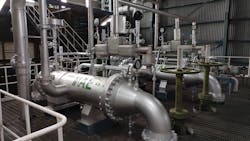Vacuum Innovations in Chemical Plants: Ejectors vs. Liquid-Ring Pumps
Recently, a petrochemical company wanted to look at replacing individual vacuum systems used in multiple parts of the plant with a central vacuum system. The most common vacuum devices in chemical processing environments include vacuum ejectors or liquid-ring vacuum pumps. Both can be considered as compressors drawing gas from a closed system and discharging it to a higher-pressure destination.
This client was using many small ejector systems and wanted to switch to a centralized liquid-ring pump system. The benefit for this change would be reducing steam consumption and lower CO2 emissions by shifting away from the steam-driven ejectors and toward the electric motors on the liquid-ring pumps. This example highlights the advantages and disadvantages of both systems, including implementation challenges.
How Does an Ejector System Work?
Most ejector systems use steam as the motive fluid to provide vacuum. The ejector system consists of the ejector, the condensers and condensate handling. In contrast, the liquid-ring vacuum pump uses a motor to operate a positive displacement compressor using a liquid ring to move the process gas. The liquid-ring system requires a discharge separator, plus liquid handling that might include cooling, liquid cleaning and liquid cooling.
Lower suction pressures, typically below 45 mmHg pressure, favor ejector systems. Higher discharge pressures, typically above 3 PSIG, favor liquid-ring systems. Additionally, availability of thermal energy (steam) favors ejectors.
Critical Client Considerations
When the client approached with the proposed upgrade, multiple questions came up. The first was that each vacuum had to be a different pressure, so would the system be controllable? Also, the common vacuum system would have to run at a pressure below the lowest-required process pressure, so how much energy would liquid-ring pumps save? The third question: Would liquid-ring pumps be reliable enough?
Answering the first question was relatively straightforward. Based on my experience in many commercial systems with operating pressures in the range of 10 mmHg (0.2 psia) to 150 mmHg (~3 psia), conventional commercial control valves can control system pressure in vacuum systems if they are properly selected and installed. Since relatively absolute pressure drops are required, butterfly valves are typically used in these systems.
The second question relates to cost. For this customer, having to run the entire common system down to the lowest-required process pressure doubled the power load compared to using individual vacuum systems for each service. The extra suction volume requirements also required a much larger compressor. Additionally, the common system requires more piping to connect all the vacuum users to one common system. Since the pressure drop needed to be low, the new piping would need to be a relatively large diameter.
The third point was a more contentious area. Ejectors are usually highly reliable. In contrast, liquid-ring vacuum pumps have demonstrated more variability. The plant had been using liquid-ring pump systems in several places. The existing liquid-ring pump systems varied from extremely reliable to persistent problems. The plant had no clear understanding of why some worked well and others did not.
Key Observations and Recommendations
Anecdotally, I’ll offer my own personal observations. What tends to make liquid-ring pump systems more reliable is (1) lower power, (2) lower rotating speed, (3) careful installation and (4) keeping the liquid-ring seal fluid clean. Using a smaller size and lower rotating speed reduces the kinetic energy in the liquid-ring. Reducing kinetic energy seems to improve reliability in nearly all machine systems. Also, lower system energy minimizes stress on the system and improves mechanical reliability, and careful installation reduces vibration-induced problems. The last point is also relatively straightforward: Cleaner systems have fewer problems.
Based on having one common vacuum system, the new liquid-ring system would require two parallel 50% capacity units of the largest liquid-ring compressor I would recommend using. This was going to be a large, high-energy system with a large potential for operating problems. Issues on a common system would potentially shut down the entire plant.
My final recommendation was to avoid a fully common system. Splitting users into groups with similar suction pressures in each group reduced liquid-ring pump size and power needed. Since systems can run at different pressures, the client didn’t have to pull the entire system down to the lowest system pressure.
Even with the power dropped by using multiple liquid-ring systems, the energy economics for this location were roughly neutral. The operating cost for boiler production of steam was roughly equal to the cost of electricity. However, the plant needed to make significant investments to replace a working vacuum ejector system with a working liquid-ring system.
In my opinion, the plant could have applied that capital toward other projects that would have reduced CO2 emissions more effectively.
About the Author
Andrew Sloley, Plant InSites columnist
Contributing Editor
ANDREW SLOLEY is a Chemical Processing Contributing Editor.

